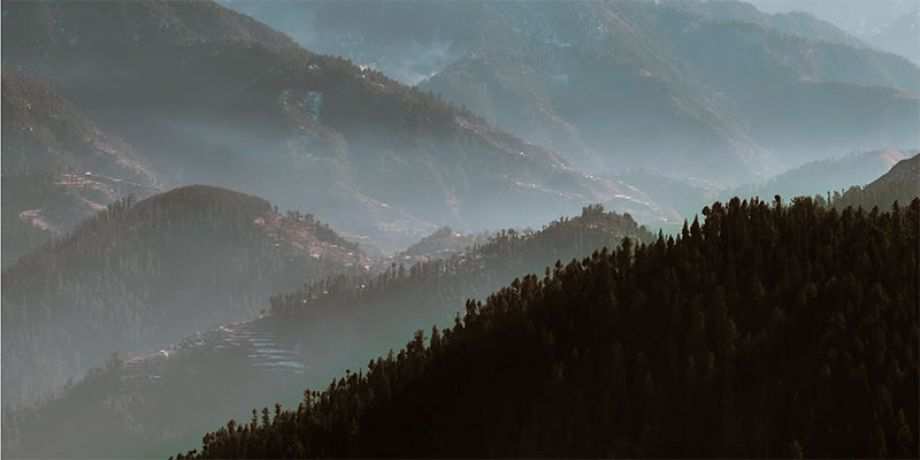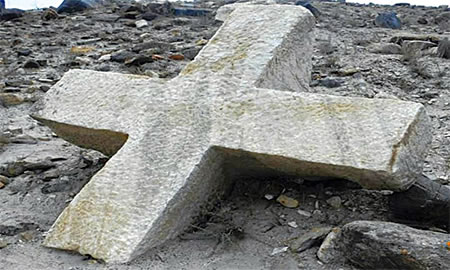
In early 2019, a group of young Muslim men discovered a large, monumental carved marble cross on the mountain side above their village in the Kavardo Valley in Skardu in the far northern part of Pakistan. The cross was upside down and almost completely buried in the dry stony soil of the mountain. This geographical area has no rain but is covered in deep snow every winter. The cross seems to have rolled down the mountainside due to earthquakes and landsides over a very long period.

In 2020, three researchers from the recently established University of Baltistan in Skardu, led by Dr. Zakir Hussain Zakir, happened to visit the village in search of any artifacts such as utensils, wood carvings and weapons as part of the university-sponsored project to preserve the culture of the people of Skardu valley. They were given hospitality in the village, but the villagers said they were too poor to have any such objects. As the village leader was walking the researchers back to their jeep, he casually mentioned that something had been found some months earlier but that it was a long way up the mountain side and would probably be too far away for them to get to. Fortunately, Dr. Zakir and his companions immediately turned around to climb the mountain. That was the beginning of the academic and archaeological interest in what is now called the Kavardo Cross.
Much has happened since then to try and discover the origin and purpose of the cross. In June 2020 a small group of Muslim and Christian academics, led by the vice chancellor of the University of Baltistan, Dr. Naeem Khan, visited the new archaeological site. There has been national and international media coverage. An academic conference was held in August in Skardu and another in October in Islamabad. During the August conference, opinion was divided as to whether the discovery of the cross could be proof of the existence of Christianity in Skardu before the arrival of Islam in the 14th century.
When the October conference was held, the overall opinion was that it was most likely an ancient Christian cross which should not be regarded as a threat to the present national or religious reality of Pakistan. The Kavardo Cross was recognized as an important testimony to the multilayered reality of the peoples who lived for thousands of years within what is now Pakistan and especially in Skardu.
The University of Baltistan estimates the weight of the cross to be three or four tons. Vertically it measures six feet and seven inches while horizontally six feet four inches. The front side is finely finished while the back side is rough. The base stem of the cross is very slightly broken. The University of Baltistan estimates it to be 1,000 to 1,200 years old.
I visited the site of the Kavardo Cross with Fr. Gulshan Barkat in September 2021, and I now act as the cultural ambassador of the University of Baltistan to promote academic research and collaboration with other universities in the archaeological research needed to unlock the secrets of this cross.
Geographically, the place of the discovery of the cross is a mountain in the Kavardo valley facing the right bank of the Indus River. Behind the cross is the gigantic Karakoram Range while at the foot of the mountain, where the cross was found, is the Indus River joined by its tributary, the Shigar River. On the left bank of the Indus are the colossal Himalayas. The cross would have been positioned on the mountain facing east so that it overlooked the Indus River, the Himalayas and the Skardu valley. The area is now full of olive and apricot trees. The village near the mountain where the cross was discovered is thirty kilometers from the city of Skardu.
Skardu is not only the geographical meeting point of the Hindu Kush, Karakoram and Himalaya ranges and the Indus River but it is also an important part of the Silk Road which connected China through what is now northern Pakistan and Central Asia with the Persian Empire and beyond to Syria and Constantinople. Adventurous modern tourists and equally inquisitive and scholarly archaeologists and historians have turned their attention to the ancient Silk Road. The Silk Road seems to be the antique version of the modern Belt and Road Initiative which is a global infrastructure development strategy of the present Chinese government.
How did the Kavardo Cross come to be where it is? Obviously, the presence of a cross means the presence of Christians. The spread of Christianity into the Skardu valley seems to have had two sources after 500 AD. Firstly, by Christians from the nearby Persian Empire which included present-day Iran, Iraq and Afghanistan and by Christians from the ancient Sogdian civilization which comprised parts of present-day Tajikistan and Uzbekistan and the cities of Samarkand and Bukhara. Secondly, through the evangelization carried out by Syrian monks who were active up and down the Silk Road and even in China at this time. The present hypothesis is that the Kavardo Cross was set up in about 800 AD by Syrian monks who had links to the Sogdian Christians and who may also have established a monastery near where the cross was found in 2020.
There is a sense of excitement around the intellectual and archaeological challenges surrounding the discovery of the Kavardo Cross. The site of the cross is, for the moment, secure. The people of the nearby village own the land and have donated four acres where the site is. The villagers themselves control the access ascending up the mountain to the cross.
However, it is of serious concern that the cross and the site of the discovery remain open to the natural elements and possible human threat.
Columban Fr. Robert McCulloch lives and works in Rome.